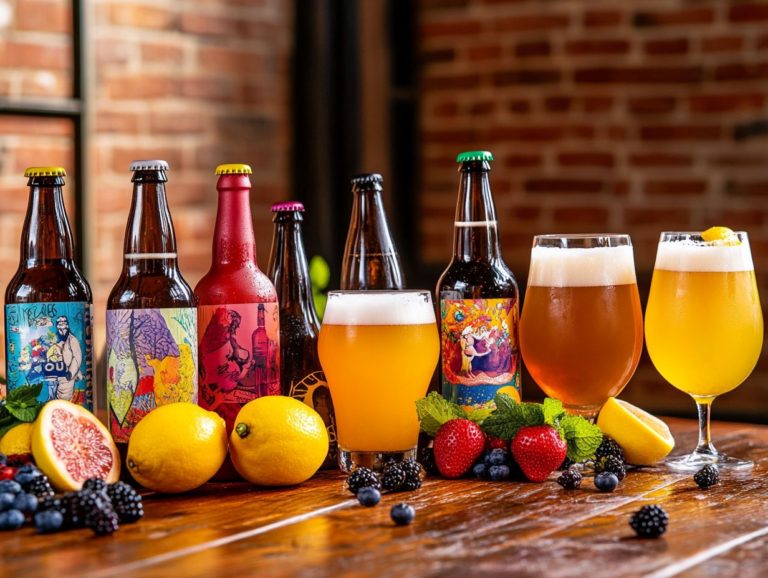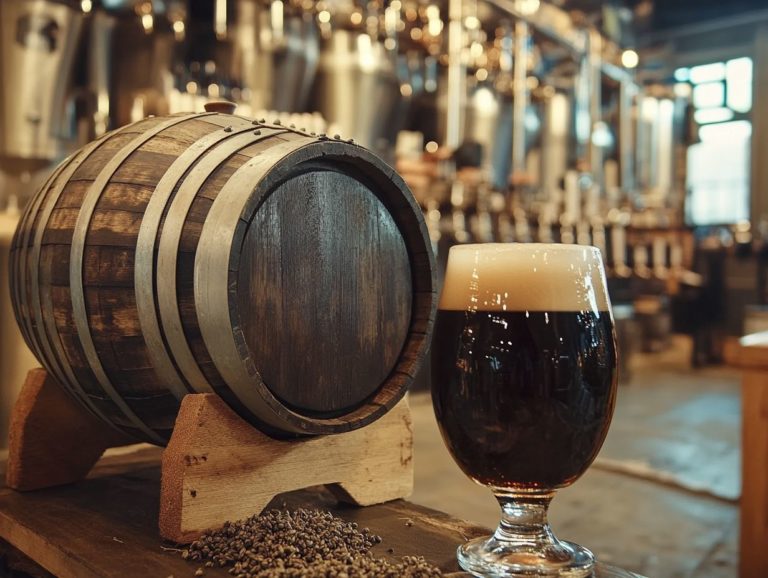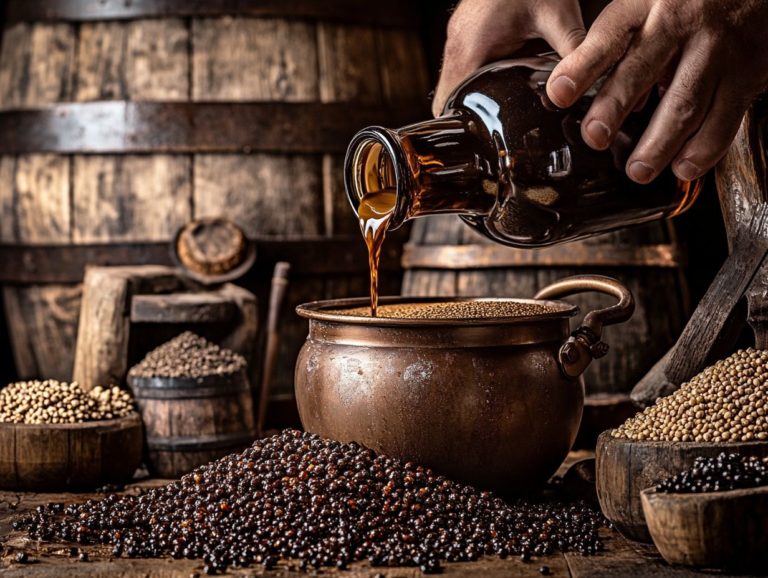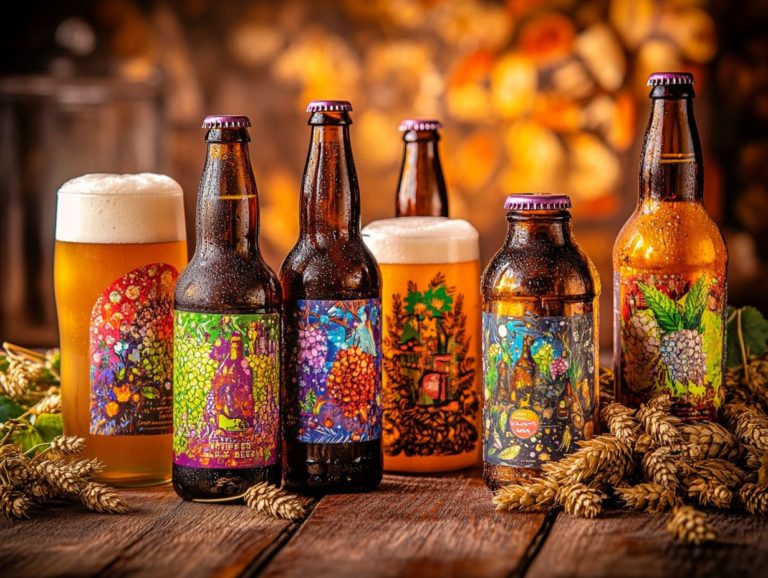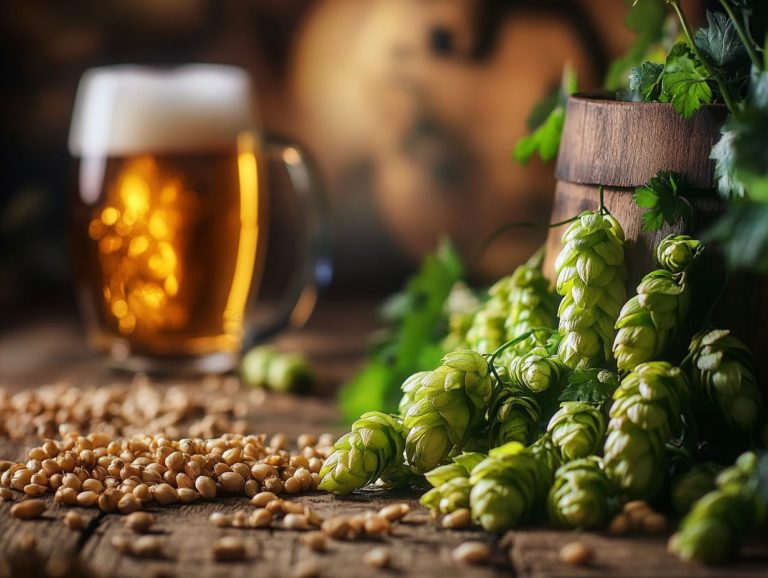What is a Cream Ale? Discovering This Style
Contents
- Exploring the Delightful World of Cream Ale
- Key Takeaways:
- What Is a Cream Ale?
- History of Cream Ale
- Ingredients in Cream Ale
- Adjuncts
- How Is Cream Ale Made?
- Brewing Process
- Fermentation
- Cold Conditioning
- Flavor Profile of Cream Ale
- Appearance
- Aroma
- Taste
- Food Pairings with Cream Ale
- Popular Brands of Cream Ale
- How to Serve and Drink Cream Ale
- Frequently Asked Questions
Exploring the Delightful World of Cream Ale
Dive into the delightful world of cream ale, a beer style that promises refreshing sips and rich history! Cream ale is a delightful and refreshing beer style that artfully blends the crispness of lagers with the smoothness of ales. As a hybrid beer, it represents an interesting intersection of traditional brewing techniques.
Originating in the United States, this unique brew, also known as American cream ale, boasts a rich history and a distinct flavor profile that has earned it a special place among beer enthusiasts. Explore its origins, key ingredients, and the brewing process that yields its signature taste.
You will also discover perfect food pairings, popular brands to try, and expert tips on serving this creamy classic to elevate your enjoyment. Popular beer brands such as Genesee Cream Ale and 21st Amendment Brewery offer excellent representations of this beer style.
Key Takeaways:
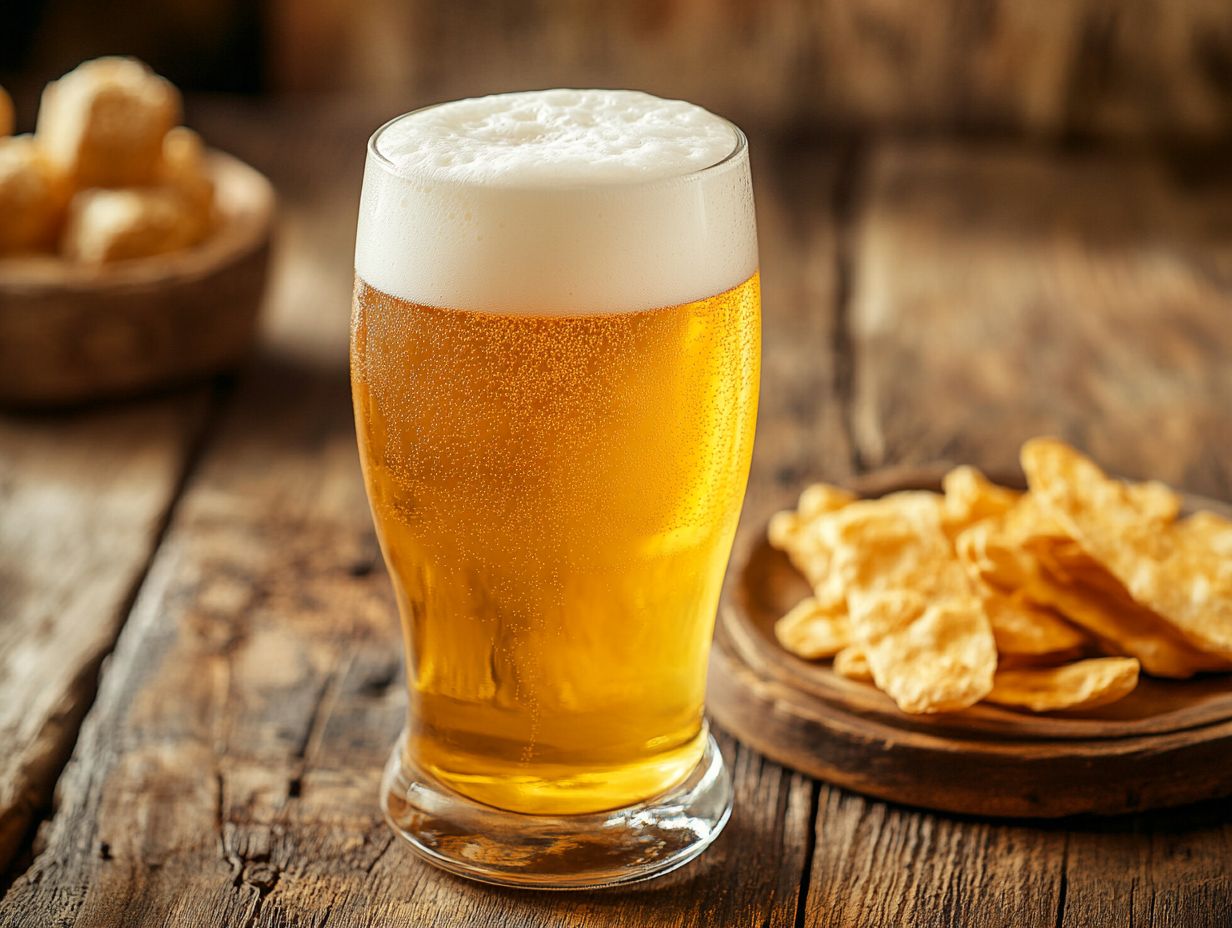
- Cream ale is a light, refreshing beer style with a smooth and creamy mouthfeel.
- Originally created in the United States, cream ale is a hybrid of lager and ale, resulting in a unique flavor profile that aligns with the standards set by the Beer Judge Certification Program.
- With its balanced malt, hop, and yeast notes, cream ale pairs well with a variety of foods and can be enjoyed at any occasion.
What Is a Cream Ale?
Cream Ale is a distinctive beer style that hails from the United States, merging the refreshing traits of an American light lager with the richer flavors commonly found in ales. This hybrid beer shines with its smooth, light-bodied profile, making it the perfect selection for anyone in pursuit of a refreshing and easy-drinking beer.
Typically brewed with pale malts, a cream ale offers a crisp finish that resonates with a diverse audience of beer enthusiasts. The inclusion of corn used in brewing introduces a delicate sweetness, enriching the overall flavor complexity of this delightful beverage.
The malt profile and the brewing recipe play a crucial role in defining its final character.
History of Cream Ale
The history of cream ale is a fascinating tapestry woven into the fabric of American brewing traditions. It dates back to the mid-19th century when brewers embarked on a quest to craft a unique beer style that would resonate with a broader audience. This historical brewing period saw the emergence of many regional beers that contributed to the diverse flavor complexity found in today’s brews.
In response to the burgeoning popularity of light lagers, cream ale emerged as a smooth and refreshing alternative, effortlessly balancing drinkability with flavor. As American breweries began to push the boundaries of brewing techniques, cream ale established itself in regional markets, especially in areas renowned for their lager production.
Over time, it evolved into a cornerstone of the craft brewing movement, cherished by enthusiasts for its approachable character and remarkable versatility.
Origins in the United States
Cream ale emerged in the United States during the 19th century as brewers sought to develop a light beer capable of competing with the burgeoning popularity of lagers, particularly the American light lager. This endeavor was significantly shaped by the influx of German immigrants, who brought their rich brewing traditions to the New World, skillfully blending local ingredients with their time-honored techniques.
In the Midwestern states, where fresh water and abundant agricultural resources were plentiful, many of the earliest cream ales were artfully crafted, allowing for a spirit of experimentation to flourish. Esteemed American breweries, such as Genesee Brewing Company and Pabst Brewing Company, played pivotal roles in cementing this style within the tapestry of American brewing.
As the decades have rolled on, cream ales have continued to evolve, embracing a variety of flavors and adapting to the ever-changing preferences of consumers while preserving the smoothness and refreshing qualities that define this beloved style. Modern craft brewers continue to experiment with this beer style, ensuring its relevance in today’s beer tasting and competitions.
Ingredients in Cream Ale
Cream ale is a popular choice among beer lovers due to its distinctive flavor profile and smooth, approachable character. The ingredients are meticulously selected to create this delightful brew. A typical brewing recipe includes a blend of pale malts, hops, yeast, and adjuncts, which are extra ingredients like corn used to enhance flavor.
Each element is essential in shaping the beer’s identity. The malt provides body and sweetness, while the hops contribute a gentle aroma that enhances without overwhelming with bitterness.
Malt
The malt profile of cream ale is typically built around pale malts, which contribute to its inviting light color and smooth mouthfeel. This ensures that the beer remains approachable and refreshingly delightful.
High carbonation levels often complement this malt profile, enhancing its soft body and drinkability. These pale malts form the backbone of the beer, offering a delicate sweetness that beautifully balances the overall flavor profile.
When combined with other ingredients like hops and adjuncts, they enhance the smoothness and drinkability that cream ales are celebrated for. By utilizing a variety of pale malts, you can experience nuanced layers of flavor.
These range from subtle biscuit notes to gentle hints of caramel. The interplay between these malts and other components adds complexity without overwhelming your palate, leading to a refreshing finish that keeps you coming back for more.
Hops
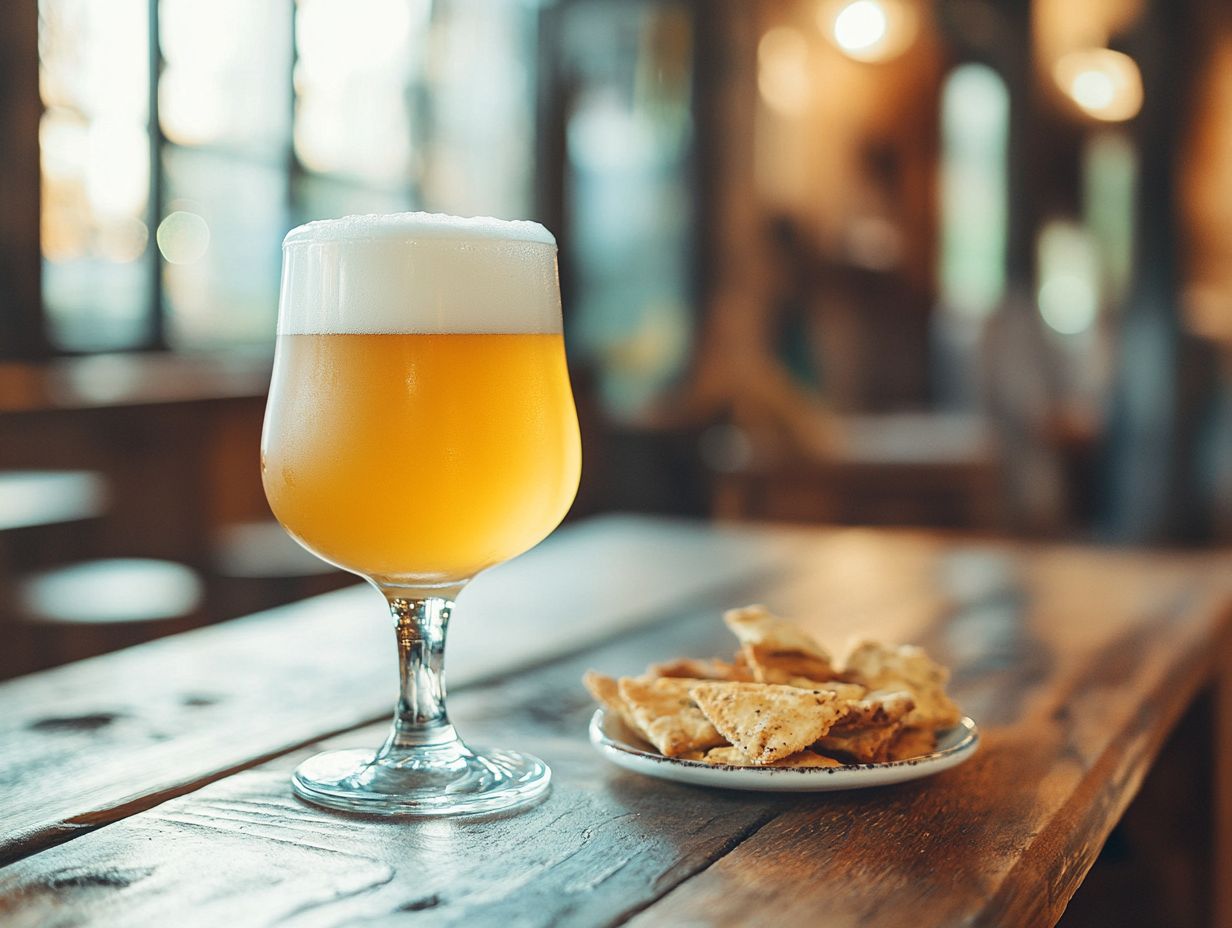
In cream ale, you’ll notice that hops are used with a light touch, preserving the beer s easy-drinking character. This approach provides a mild hop bitterness and a subtle hop aroma that enhances your palate.
You ll typically encounter varieties like Cascade, Fuggles, and Willamette, each chosen for their floral and earthy notes that harmonize beautifully with the creamy mouthfeel. These hops work together to create a balanced flavor profile, enriching your overall experience.
Brewers often add hops late in the boil or as a dry hop. This technique captures their aromatic qualities without significantly ramping up the hop bitterness, resulting in a smooth and refreshing finish that appeals to a broad spectrum of beer enthusiasts.
Yeast
The fermentation process in cream ale typically employs lager yeast, which contributes to a clean finish, allowing the subtle flavors of the beer to truly shine through. This particular yeast is renowned for its ability to work well in cooler conditions, playing a crucial role in crafting a crisp and refreshing profile.
Controlling the fermentation environment is crucial, as temperature significantly impacts yeast activity and ultimately the overall taste of the ale. By maintaining a consistent and appropriate temperature, you can ensure that the yeast remains active without veering into off-flavors.
The outcome is a beverage that not only highlights the creamy texture many seek but also features delicate notes that tend to be overshadowed in ales fermented with more dominant yeast strains. This meticulous approach elevates the drinking experience, allowing you to savor every nuance of this delightful brew!
Ready to savor this refreshing brew? Visit your local brewery today!
Adjuncts
Corn adjuncts play an important role in many cream ale recipes, infusing a subtle sweetness and contributing to the light body that defines this refreshingly delightful beer style. This ingredient smooths out the drink and cultivates a more approachable profile, making it a favorite among craft breweries eager to introduce new drinkers to the fascinating world of beer.
You might notice the use of corn varies greatly; some breweries may opt for flaked corn to strike a delicate balance between flavor and mouthfeel, while others may choose corn syrup for improved fermentation efficiency and a whisper of sweetness. This variation in corn flavor can make each brew unique and adds to the overall charm of cream ales. This diverse approach transforms the beer s feel, making each sip a thrilling experience.
In the South, for example, you ll find corn integrated into traditional recipes. In contrast, Northern brews may lean toward alternative grains to highlight their unique regional character.
How Is Cream Ale Made?
The brewing process for cream ale encompasses several essential stages, including the initial brewing steps, fermentation, and cold conditioning. Each of these stages plays an important role in shaping the smooth and refreshing character of the final product. This process is frequently discussed in beer fermentation forums and brewing history articles, reflecting its enduring popularity among craft beer enthusiasts.
After you mash the ingredients, the next step is to boil the wort and incorporate hops. Following this, you ll need to cool it down and transfer it to fermentation vessels.
Brewing Process
The brewing process of cream ale commences with mashing pale malts to extract those all-important fermentable sugars. This mixture is then boiled with hops, transforming it into a flavorful wort before fermentation takes place.
This initial step is important; the temperature and duration of the mashing can significantly impact the beer’s body and flavor profile. After mashing, you ll need to keep a close eye on the lautering process (the process of separating liquid wort from grains), where the liquid wort is separated from the spent grains. Here, you can apply different techniques, such as batch or continuous sparging, each imparting unique characteristics to the brew. Renowned beer historian Jeff Alworthy often discusses these techniques in detail.
Once you’ve collected the wort, it s time to transfer it to a kettle for boiling. During this stage, you’ll add hops for their bitterness, aroma, and preservative qualities. The decisions you make during these stages everything from the types of hops to when you add them will collectively shape the final taste of your beer. This offers an exciting opportunity for innovation, as various breweries play around with these methods to create distinct flavors.
Many American ales owe their unique characteristics to such innovative techniques.
Fermentation
During fermentation, American cream ale typically employs lager yeast at carefully controlled temperatures, resulting in a remarkably clean taste that allows the delicate flavors of malt and hops to develop freely. This beer style often includes corn adjuncts, contributing to a unique flavor profile.
This careful fermentation process generally occurs at cooler temperatures, typically between 50 F and 55 F, contributing to a crisp and refreshing profile. The choice of yeast strains is crucial; certain strains ferment more cleanly and produce fewer aromatic by-products, ensuring that the beer retains its smooth character.
The fermentation period can range from one to two weeks. During this time, any unwelcome fermentation by-products, such as diacetyl which can impart undesirable buttery flavors diminish significantly. This careful balance of temperature and yeast selection ultimately enhances the beer s flavor and aroma, allowing the subtle complexities of the cream ale to truly shine through.
Ready to experience the unique flavors of cream ale? Grab your ingredients and start brewing today!
Cold Conditioning
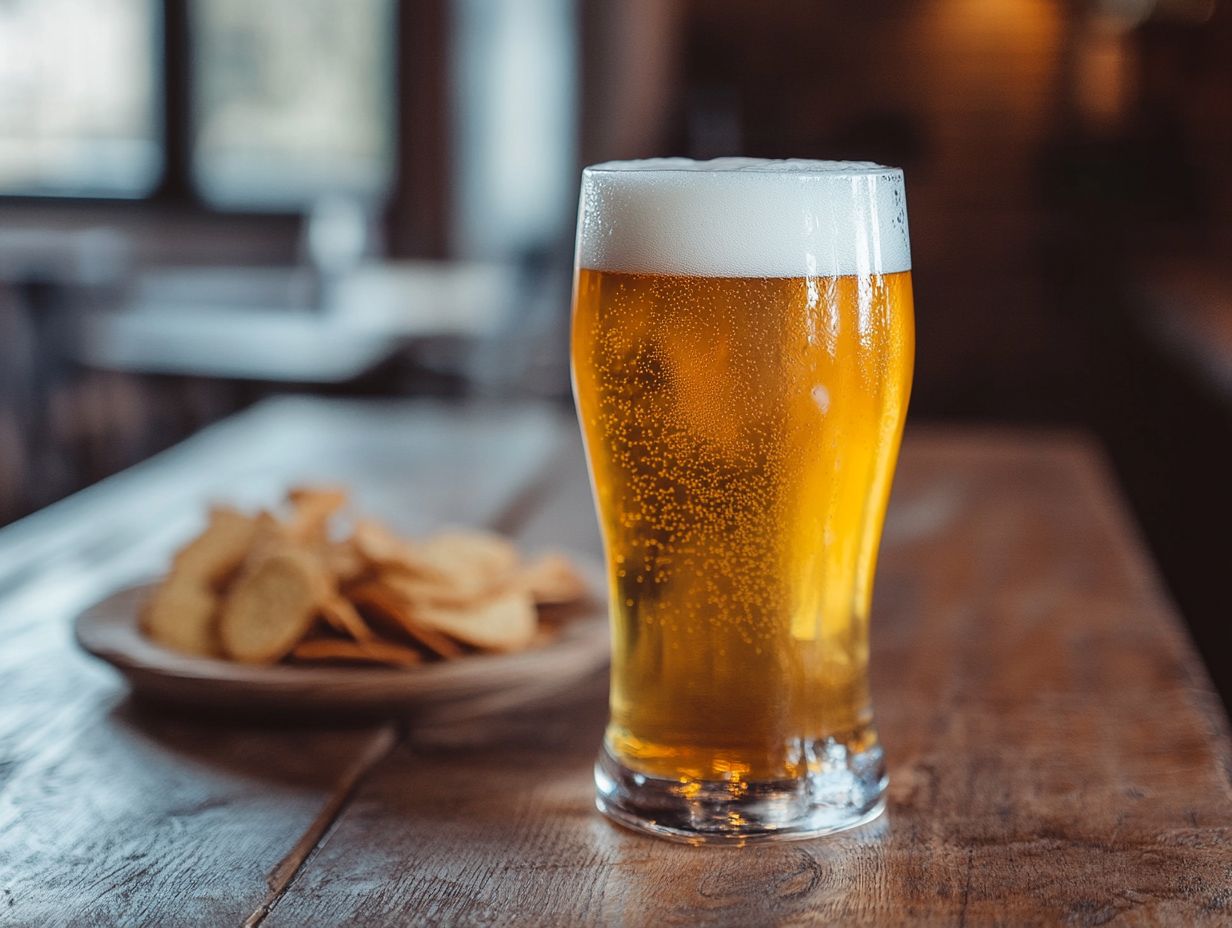
Cold conditioning is an essential phase in the creation of cream ale, where the beer undergoes a cold conditioning process that elevates its smoothness and enhances its clarity before it reaches the packaging stage.
This careful brewing process spans several days to weeks, providing ample time for carbonation to develop fully while any unwanted flavors or particulates settle down. During this period, yeast and proteins work in harmony, refining the beer’s texture and ensuring an inviting mouthfeel.
The cooler temperatures in the conditioning phase play a vital role in stabilizing the beer, preventing any off-flavors, and guaranteeing a clean finish.
Ultimately, the duration and conditions of this maturation phase significantly impact the overall quality of the cream ale, allowing it to achieve that perfect balance of flavor and body that you, as a discerning drinker, have come to expect.
Flavor Profile of Cream Ale
The flavor profile of cream ale captivates with its light body, smooth mouthfeel, and perfectly balanced taste. It positions itself as an exceptional choice for discerning beer enthusiasts who appreciate easy-drinking ales.
This light-bodied ale includes pale malts and corn adjuncts, enhancing its drinkability. In terms of appearance, you ll notice cream ale typically showcases a pale straw hue paired with lively carbonation.
You ll love the mild aroma that invites you in, revealing nuanced hints of corn and malt that enhance its overall appeal.
Appearance
Cream ale often presents a pale straw color that is not only visually appealing but also indicative of its light beer classification. This hue draws in those who crave a refreshing beverage.
This inviting hue is complemented by a brilliant clarity that allows light to pass through effortlessly, enhancing its overall allure. The carbonation level typically found in cream ales elevates the experience, producing a fine effervescence that dances delightfully across your palate.
As you examine the glass, the charming bubbles rising to the surface create an enticing visual spectacle that promises a lively mouthfeel.
These visual characteristics are essential, as they captivate potential drinkers and lay the groundwork for an unforgettable tasting journey, shaping your expectations before that first delightful sip.
Aroma
The aroma of cream ale greets you with a mild, slightly sweet fragrance, infused with subtle notes of corn and malt that invite you into a delightful sensory experience.
This exquisite balance is crafted from carefully selected ingredients; the sweetness from the malt dances gracefully with delicate hop aromas, adding a layer of complexity without overshadowing the overall profile.
Hops introduce floral or citrusy hints, enhancing the cream ale’s freshness and encouraging you to appreciate its refined character.
The addition of flaked corn contributes to a smooth texture and achieves a subtly creamy mouthfeel, enriching the aromatic tapestry even further.
As you savor this brew, each sip reveals a harmonious interplay between sweet and hoppy notes, transforming your tasting experience into something truly unique and enjoyable.
Taste
The taste of cream ale presents a harmonious balance between the sweetness of malts and a light hop bitterness. This results in a refreshing and easy-drinking beer that suits a multitude of occasions.
This delightful brew often reveals a subtle creaminess, courtesy of flaked corn or other adjuncts, which contributes to its exceptionally smooth mouthfeel.
As you explore its layers, you ll discover hints of caramel and biscuit-like sweetness that blend seamlessly with the mild floral and herbal notes derived from the hops. The low to moderate bitterness enhances the overall profile, ensuring that no single flavor overpowers the others.
Don’t miss this delicate interplay of flavors that promises to elevate your tasting experience, inviting you to truly savor each sip.
Food Pairings with Cream Ale
Cream ale’s light and refreshing qualities make it an exceptional companion for various food pairings, improving your meal with its smooth, easy-drinking nature. Its balanced flavor profile is perfect for enhancing a variety of dishes.
Whether you’re enjoying a casual lunch or a more elaborate dinner, this versatile beer beautifully enhances an array of dishes. If you re a seafood lover, you ll find that creamy pastas and shrimp scampi become even more delightful with the gentle sweetness and crispness of cream ale. This beer style’s corn flavor also pairs well with seafood.
For those indulging in heartier options like grilled sausages or BBQ chicken, you’ll love how its smooth body perfectly balances those rich flavors!
Even a salad featuring citrus dressing or roasted vegetables can harmonize beautifully, allowing the beer’s subtle malt profile to shine through without overwhelming your palate. Cream ale’s flavor complexity makes it a versatile choice for various food pairings.
Popular Brands of Cream Ale
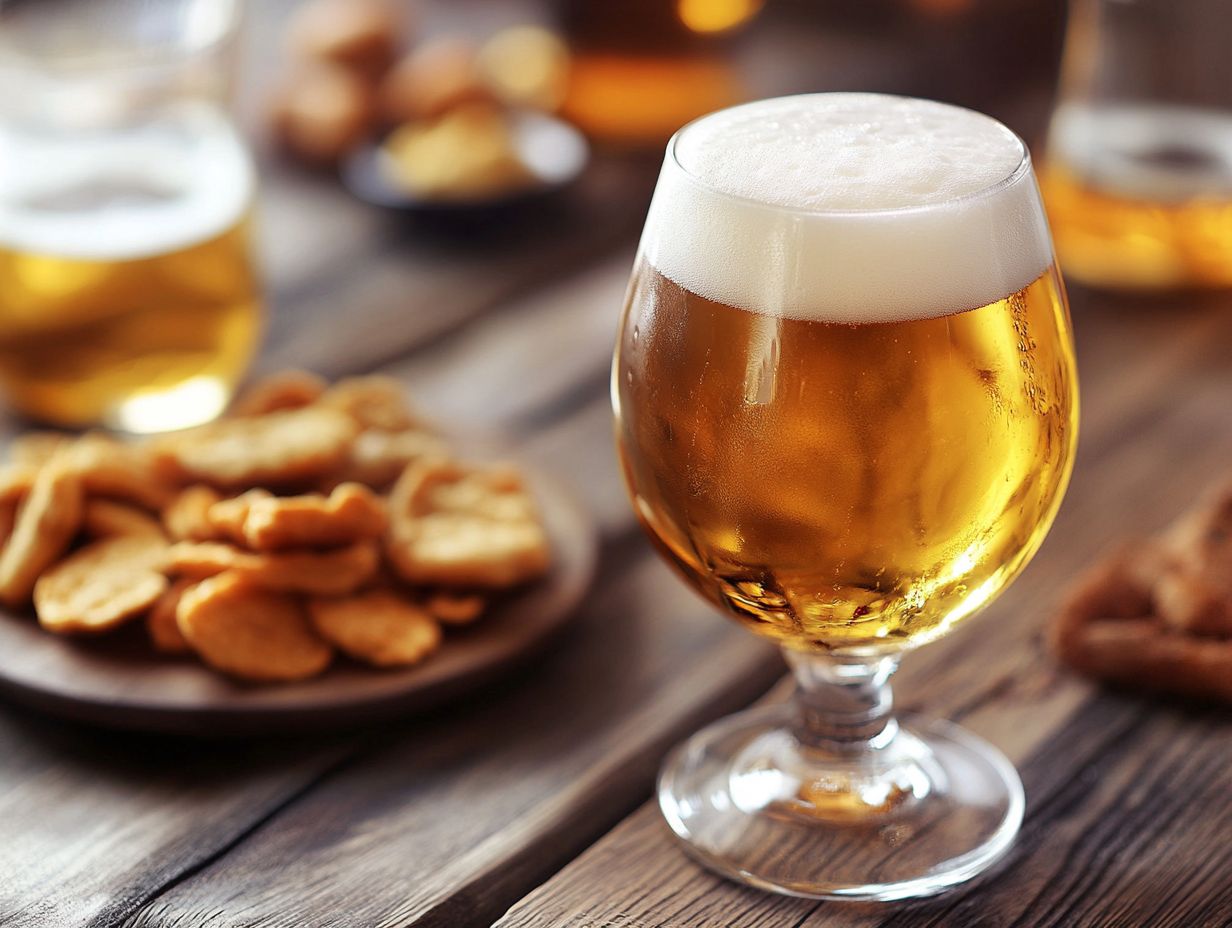
Several prominent brands of cream ale have made a notable impact in the craft beer scene. Genesee Cream Ale is one of the most recognized examples of this style in the United States.
Other notable American breweries crafting cream ales include:
- Mother Earth Brew Co.
- Lexington Brewing & Distilling Co.
- 21st Amendment Brewery
Beyond Genesee, a variety of craft breweries have crafted their own distinctive interpretations of cream ale, each contributing to its rising popularity.
Take Carton Brewing Company from New Jersey; they offer a unique version that emphasizes a crisp, clean finish, skillfully balancing malt sweetness with subtle hop notes for a truly refreshing experience. Another example is Bissell Brothers Brewing Co., known for their innovative brewing techniques.
Hardywood Park Craft Brewery from Virginia injects a dash of creativity into the mix with their limited-edition cream ales, often infused with seasonal flavors that showcase their commitment to innovation. Vitamin Sea Brewing also stands out for their inventive take on this beer style.
These breweries, along with many others, play a crucial role in broadening the appeal of cream ales, illustrating that there s far more to this beer style than initially meets the eye. For instance, Newburgh Brewing Co. and Detroit Beer Co. have also made significant contributions to the popularity of cream ales.
How to Serve and Drink Cream Ale
Serving and enjoying cream ale at the perfect temperature can significantly enhance its refreshing qualities, transforming your experience into a delightful journey for any beer enthusiast in search of an easy-drinking option. Following BJCP (Beer Judge Certification Program) guidelines can improve your tasting experience.
Serve cream ale chilled, ideally between 40 F and 45 F (4 C to 7 C). This range allows the delicate flavors to emerge brilliantly, free from the overpowering chill of overly cold temperatures. The high carbonation level in cream ales also benefits from this serving temperature.
Selecting the right glassware is crucial; a traditional pint glass or a flared lager glass will beautifully showcase the ale s color and carbonation. When pouring, remember to gently tilt the glass to craft a lovely head without creating excessive foam. This technique is essential in beer competitions and for beer history enthusiasts.
Don t overlook the overall presentation. Garnishing your glass with a slice of lemon or a sprig of mint can elevate its visual appeal, enhancing not just aesthetics but also your drinking experience. Engaging the senses in this way amplifies your enjoyment and deepens your appreciation for the craftsmanship behind the beer. Many craft brewers emphasize presentation to highlight their brewing tradition.
Frequently Asked Questions
What is a Cream Ale?
A Cream Ale is a type of beer that originated in North America. It is a light, refreshing, and easy-drinking style of beer that is typically brewed as an ale but is often lagered for a clean, crisp finish. This hybrid beer combines the best qualities of ale and lager brewing techniques.
How is a Cream Ale different from other popular beer styles?
Cream Ales are similar to American Pale Lagers. They have a slightly sweeter and smoother taste due to the use of corn or rice in the blend of grains.
They also have a lower hop bitterness and a lighter body compared to other ales. This beer style’s light classification makes it an easy-drinking option.
What is the history behind Cream Ales?
Cream Ales were first brewed in the mid-19th century in North America as a response to the growing popularity of lager-style beers. They combine the drinkability of lagers with the flavor and character of ales.
Early American brewers used innovative techniques to create this mix of different beer styles.
How are Cream Ales brewed?
Cream Ales are typically brewed using a combination of barley, corn or rice, and sometimes oats. The grains are mashed and boiled with hops to create a light and refreshing base.
A unique characteristic of Cream Ales is that they are often top-fermented like ales. However, they are then cold-conditioned like lagers, highlighting the hybrid nature of this beer style.
What food pairs well with Cream Ales?
Cream Ales are incredibly versatile and perfect for any occasion! They pair well with a variety of foods, making them a light-bodied ale choice.
They are a great match for lighter dishes such as salads, seafood, and grilled chicken. Grab a Cream Ale for your next meal and elevate your dining experience instantly!
They also go well with spicy foods, burgers, and pizza. This makes Cream Ales a popular beer for many occasions.
Are there different variations of Cream Ales and their brewing process?
Yes, there are several variations of Cream Ales. Some American breweries, such as Carton Brewing Company and Mother Earth Brew Co., add fruit or spices to create flavored Cream Ales.
Others may use different types of grains like pale malts or corn adjuncts or specific hops for a unique twist in the flavor profile. The common thread among all Cream Ales is their light, smooth, and easy-drinking characteristics, often enhanced by traditional brewing techniques and cold conditioning processes.

